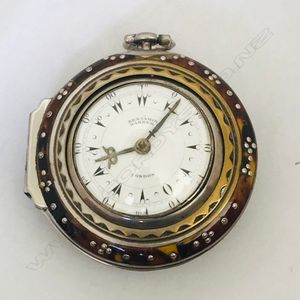George III Benjamin Barber Triple Cased Pocket Watch
George III silver Benjamin Barber triple cased pocket watch, made for the Turkish market. 64 mm tortoiseshell and silver plate outer case with studded detail, silver inner cases hallmarked London 1792 by James Richards, (specialist case maker). Signed white enamel Ottoman dial. Signed fusee verge movement. Held in three cases this is a typical example of the so-called 'onion watches' The name, originally used in France (montres oignons) coming from the protective, layered cases and their relative rotundness. Watches made for the Ottoman markets invariably had a second or, more often, third outer case generally covered in tortoiseshell. In this example, the exterior case is made of reddish brown tortoiseshell and decorated with the pique technique, a method of silver studding, that was not only decorative, but also protected the tortoiseshell from wear.
You must be a subscriber, and be logged in to view price and dealer details.
Subscribe Now to view actual auction price for this item
When you subscribe, you have the option of setting the currency in which to display prices to $Au, $US, $NZ or Stg.
This item has been sold, and the description, image and price are for reference purposes only.
- Pique Work - A decorative technique used on jewellery and small decorative objects in which designs are created by inlaying small gold or silver studs and stips into tortoiseshell. The art reached its highest point in 17th- and 18th-century France, particularly for the decoration of small tortoiseshell articles such as combs, patch boxes, and snuffboxes.
- George Iii - George III (1738 - 1820) was King of Great Britain and Ireland from 1760 to 1820.
- Tortoiseshell - Tortoiseshell is a translucent material that comes from the horny carapace of a certain types of turtles, including the hawksbill turtle. It is often therefore mounted on a colour underground - often red - or inlaid with gold or silver thread, as seen in Boulle furniture.
The texture and colour nuances of the material are extremely important. Heated tortoiseshell can easily be formed into various shapes. Like other natural materials, tortoiseshell becomes more beautiful with use. In a time before plastic, tortoiseshell was widely used for small objects such as combs and powder compacts.
In 1973, the trade of tortoiseshell worldwide was banned under CITES (The Convention on International Trade in Endangered Species). Prior to importing or exporting items containing tortoiseshell a CITES permit must be obtained. Tortoiseshell items cannot be traded on Ebay.
"Faux tortoiseshell", another case of man initiating nature, is made from old-style plastics such as celluloid and cellulos and is coloured with red, yellow and brown spots to imitate the genuine article. It is commonly used in glasses frames, musical instruments and costume jewellery. - Fusee - The fusee movement was used in clocks and pocket watches from the mid 17th century. The fusee is a cone shaped drum within the works that is linked to the barrel of the spring, usually by a length of chain.
As the mainspring loses its tension over time, the cone shaped barrel compensates for this by increasing the tension, by pulling the mainspring tighter, thus ensuring the time remains constant.
Use of the fusee in clocks was superseded by the "going barrel" in the mid 19th century and for pocket watches at the beginning of the 19th century.
The fusee continued to be used in marine chronometers until the 1970s. - Movement - The technical name for the workings of a clock or watch, and does not include the dial or case.
This item has been included into following indexes:
- clocks, material or decoration - tortoiseshell cased 106
-
pocket watches, case type
- open face, silver case 570
- silver case 905
- pocket watches, country - French onion" (oignon)" 5
- pocket watches, period - Georgian 289
